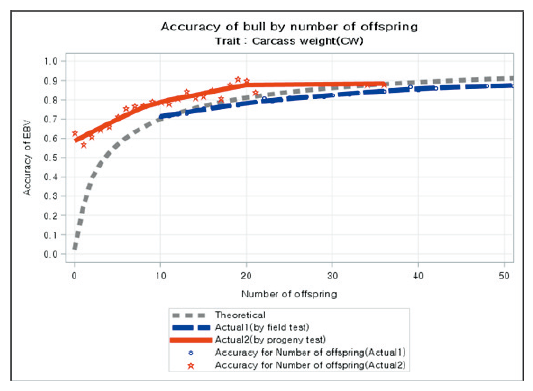Abstract
This study was conducted to solve the problem of Korean Proven Bull (KPN) currently being selected by progeny test. The Estimated Breeding Values (EBV) accuracy of KPN was estimated using the carcass traits data of Hanwoo that was raised and slaughtered directly in the farm, and the ability of KPN was re-evaluated and verified to determine whether it could be used to improve the EBV accuracy and test system of Hanwoo KPN. The heritability of Carcass Weight (CW), Eye Muscle Area (EMA), Backfat Thickness (BF), Marbling Score (MS) calculated from the estimated parameters were evaluated to be 0.23, 0.23, 0.20, and 0.27, respectively. The accuracy of EBVs estimated from farm slaughter data for KPN 643 animals with progeny's carcass traits data was 0.89, 0.85, 0.89, and 0.90, respectively, and the EBV accuracy estimated through the station progeny test was approximately 10~11% higher than farm progeny. In the progeny test, the progeny phenotypic data collected from the progeny test showed an accuracy of about 0.70 to 0.75 on average, and the proportion of KPNs with an accuracy of 0.9 or higher was 4.8%, 3.6%, 3.3% and 4.2%, respectively, in CW, EMA, BF, and MS. The accuracy of EBVs estimated from carcass traits data slaughtered at Hanwoo farms was greater than 0.7 in KPNs over 98%, and the ratio of KPNs with accuracy greater than 0.9 was 56.6%, 56.8%, 55.4%, and 58.8%, respectively, in CW, EMA, BF, and MS. This is believed to be due to the relatively high average number of progeny per KPN at 2,455 animals in farm slaughter data. In addition the carcass traits data of progeny animals was investigated to determine whether the estimated EBV for the selection of Hanwoo KPN expressed EBV's ability in the progeny born from KPN, and the corrected phenotype performance, which eliminated convenience by farm and slaughter year-season, was conducted using the investigated data. In the same way, a secondary verification EBV using the farm carcass traits data was also conducted with corrected phenotype performance and rank correlation. In comparison with progeny test EBV, the rank correlation was estimated to be 0.62, 0.57, 0.54, and 0.52, showing results below the theoretical EBV accuracy estimate of 0.78. Therefore, in order to increase the accuracy of KPN, it is necessary to increase the number of progeny test farms, increase the number of progeny test animals, and add novel traits to produce future generations that slaughter at the point of slaughter (30~31 months). This problem will be a long-term goal due to the difficulty of securing budgets and participating in farms, and it is expected that the existing KPN ranking will be able to be supplemented with a system that can re-evaluate KPN semen with field data approximately three years after production.
Figures & Tables

Fig. 1. Accuracy of bull by number of offspring (progeny) for carcass weight.


